I guess it depends what you’d use it for.I’ve been struggling with deciding on an upgrade to my nearly 10 year old retina MBP. The M2 air looks great. But the 14” pro also looks appealing with all the extra ports. I could probably hold out longer, but I would love to start transitioning to a new laptop before this one dies. So many options!
Got a tip for us?
Let us know
Become a MacRumors Supporter for $50/year with no ads, ability to filter front page stories, and private forums.
M1 vs. M2 MacBook Air Buyer's Guide: Is It Worth Upgrading?
- Thread starter MacRumors
- Start date
- Sort by reaction score
You are using an out of date browser. It may not display this or other websites correctly.
You should upgrade or use an alternative browser.
You should upgrade or use an alternative browser.
When you trade it in to Apple, they refurbish and resell it to someone else.To save this planet's life (including ours) no one should buy a new computer every two years.
It's insane from an energy and materials consumption standpoint.
Just get a device and keep it till it's unusable for your needs.
When you give it to a family member or friend or sell it to someone, they are using it. Does the planet care if you or someone else is using it?
I fail to see the issue here.
Last edited:
Well, if your retina MBP satisfies your needs now, then why upgrade? As long as your data is backed up, then the worst that can happen is that you have to buy a new computer when the current one fails. And if the MBP makes it another year then you will have newer, more powerful options.I’ve been struggling with deciding on an upgrade to my nearly 10 year old retina MBP. The M2 air looks great. But the 14” pro also looks appealing with all the extra ports. I could probably hold out longer, but I would love to start transitioning to a new laptop before this one dies. So many options!
With supply shortages, it is not a good idea to wait until something dies. Especially if you need the machine for work. Sure, things are backed up but it doesn't really help if you have to wait 2-3 weeks for delivery.Well, if your retina MBP satisfies your needs now, then why upgrade? As long as your data is backed up, then the worst that can happen is that you have to buy a new computer when the current one fails. And if the MBP makes it another year then you will have newer, more powerful options.
Exactly. Besides, if you are not going to need the extra power that a 14" MBP offers you, and if portability is a must, you'd be better off with an M1 or M2 MBA.Weighs almost 1 pound more. Has worse battery life. Much bulkier. It depends on what you want/need.
I've been asking the same question here and there, but I am still looking for an answer. The Long story short question is: M1 or M2 MacBook Air. I have a 2012 13" MacBook Air (4GB of RAM and 512GB of SSD). As a university teacher, I mainly work with Microsoft Office, videoconferencing, email, web browsing, watch movies and listen to music. My current MBA is starting to slow down and show some limitations, so I am thinking of getting a new computer in the near future. I don't know if should go for the M1 MBA or the M2 MBA. One of the thing I love about my 2012 MBA is MagSafe, but I don't know if it justifies the extra cash for the M2 MBA. I was thinking about upgrading the specs of my next MacBook to 16GB of RAM and 1TB of SSD. I ruled out the 14" MBP for two reasons: portability (I move my computer a lot and use it for presentations in all my classes) and because I think I won't be using the extra-power the MBP offers. Another thing that worries me is that the M2 MBA is losing the wedge- shape and it might have an effect in the comfort, when typing for hours. On the other hand, what makes me hesitate about going for the M1 MBA (which is still a great value) is the fact that is a 2-year-old model, with and even older chassis design. What should I do? Any recommendations?
Apple's MacBook Air with the M2 chip comes over a year and a half after its M1-based predecessor. The new device features a complete redesign as well as several important under-the-hood improvements that could make it a major upgrade worth considering for many users, even though it may not be worthwhile for some.
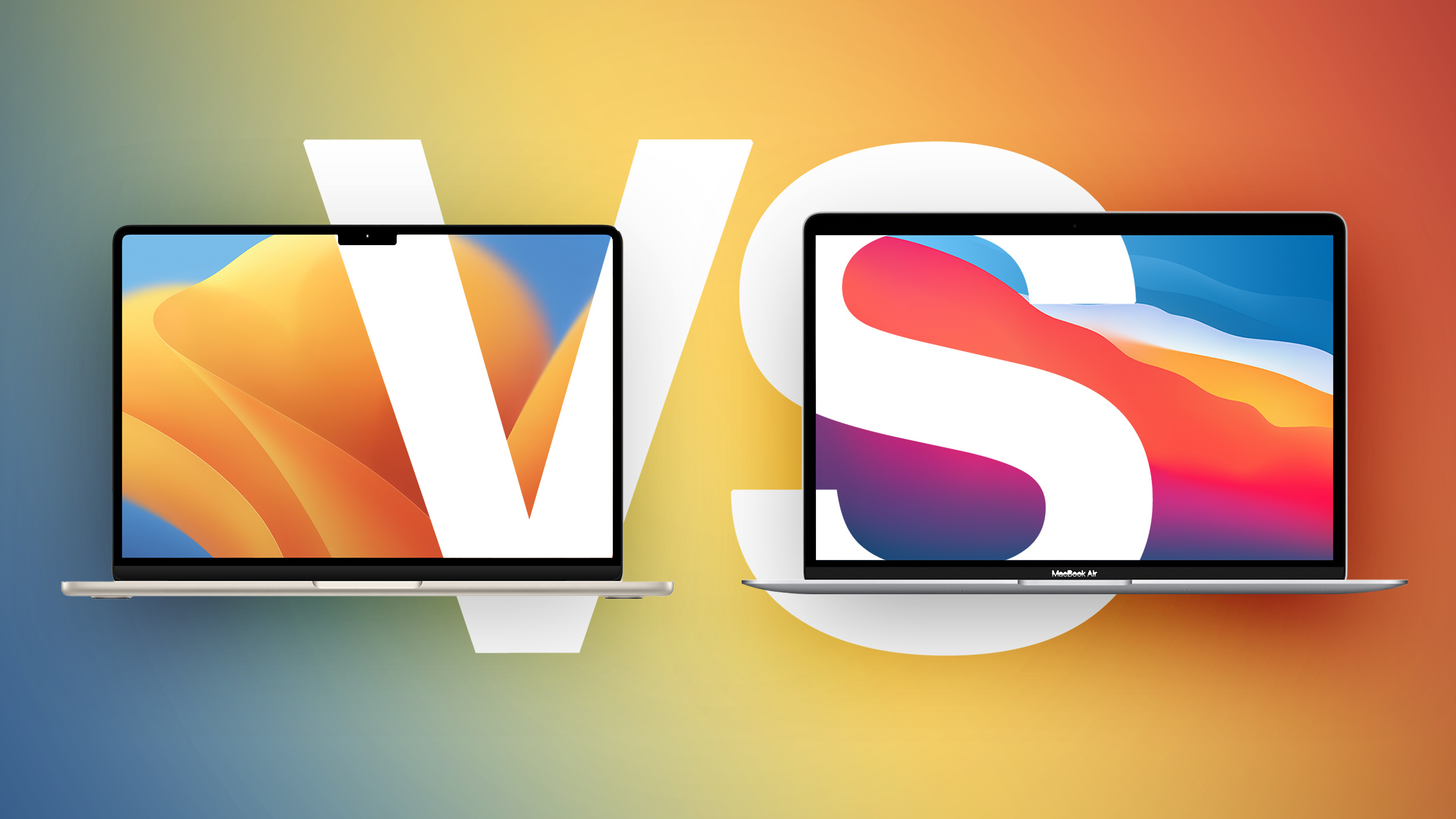
The MacBook Air is often chosen by those who require a portable, more affordable Apple laptop, with the device offering a lightweight design at a price well below the high-end MacBook Pro models. The M2 MacBook Air joins the Mac lineup at a $1,199 price point – with the previous M1 model remaining on sale for the same $999 price tag that it debuted with in November 2020.
Whether you are weighing up the upgrade from the M1 MacBook Air to the M2 MacBook Air, or are in the market for a new MacBook Air and are mulling whether it's worth saving $200 by buying the M1 model, our buyer's guide helps you to work out which of the two MacBook Air models currently on sale is best for you.
Comparing the M1 and M2 MacBook Air Models
Despite their different designs, there are still a large number of important parallels between the two MacBook Air models:
Similarities
- ~13-inch Retina display with P3 wide color and True Tone
- Ambient light sensor
- Touch ID
- Force Touch trackpad
- Fanless design with passive cooling
- Apple silicon chip with 8-core CPU
- Video encode and decode engines for hardware-accelerated H.264 and HEVC video
- 256GB, 512GB, 1TB, and 2TB SSD storage configurations
- Two Thunderbolt/USB 4 ports
- 3.5mm headphone jack
- Support for wide stereo sound and Dolby Atmos playback
- Three-mic array with directional beamforming
- 802.11ax Wi-Fi 6 and Bluetooth 5.0
- Up to 18 hours of battery life
- Available in Silver and Space Gray
Beyond their designs, there are crucial differences between the M1 MacBook Air and the new, M2 MacBook Air:
Differences
M1 MacBook Air
- 13.3-inch Retina display (2560 by 1600 pixels)
- 400 nits brightness
- Apple M1 chip with up to 8-core GPU
- 68.25GB/s memory bandwidth
- 8GB and 16GB unified memory configurations
- 720p FaceTime HD camera
- Stereo speakers
- 3.5mm headphone jack
- 49.9-watt-hour lithium-polymer battery
- 30W USB-C Power Adapter
- Available in Gold
M2 MacBook Air
- 13.6-inch Liquid Retina display (2560 by 1664 pixels)
- 500 nits brightness
- Apple M2 chip with up to 10-core GPU
- ProRes encode and decode engine for hardware-accelerated ProRes and ProRes RAW video
- 100GB/s memory bandwidth
- 8GB, 16GB, and 24GB unified memory configurations
- 1080p FaceTime HD camera
- Four-speaker sound system
- 3.5mm headphone jack with advanced support for high-impedance headphones
- 52.6-watt-hour lithium-polymer battery
- 30W USB-C Power Adapter (with 8-core GPU model) or 35W Dual USB-C Port Compact Power Adapter (with 10-core GPU model)
- Supports fast charging with 67W USB-C Power Adapter
- Available in Starlight and Midnight
Design
The most noticeable difference between two MacBook Air models is their design. While the M1 MacBook Air mirrors the design of previous models with a tapered, "wedge" design, the M2 model takes design cues from the latest 14- and 16-inch MacBook Pro models with a uniform thickness and a flat top with rounded bottom edges.

The tapered design of the M1 MacBook Air
It is ultimately a matter of personal preference which design you prefer, but the M1 MacBook Air features the exact same design that the device has been sporting since 2018, which itself carried over the tapered style Apple has used since 2010. The M2 MacBook Air uses Apple's latest design language and looks like a much more modern device.
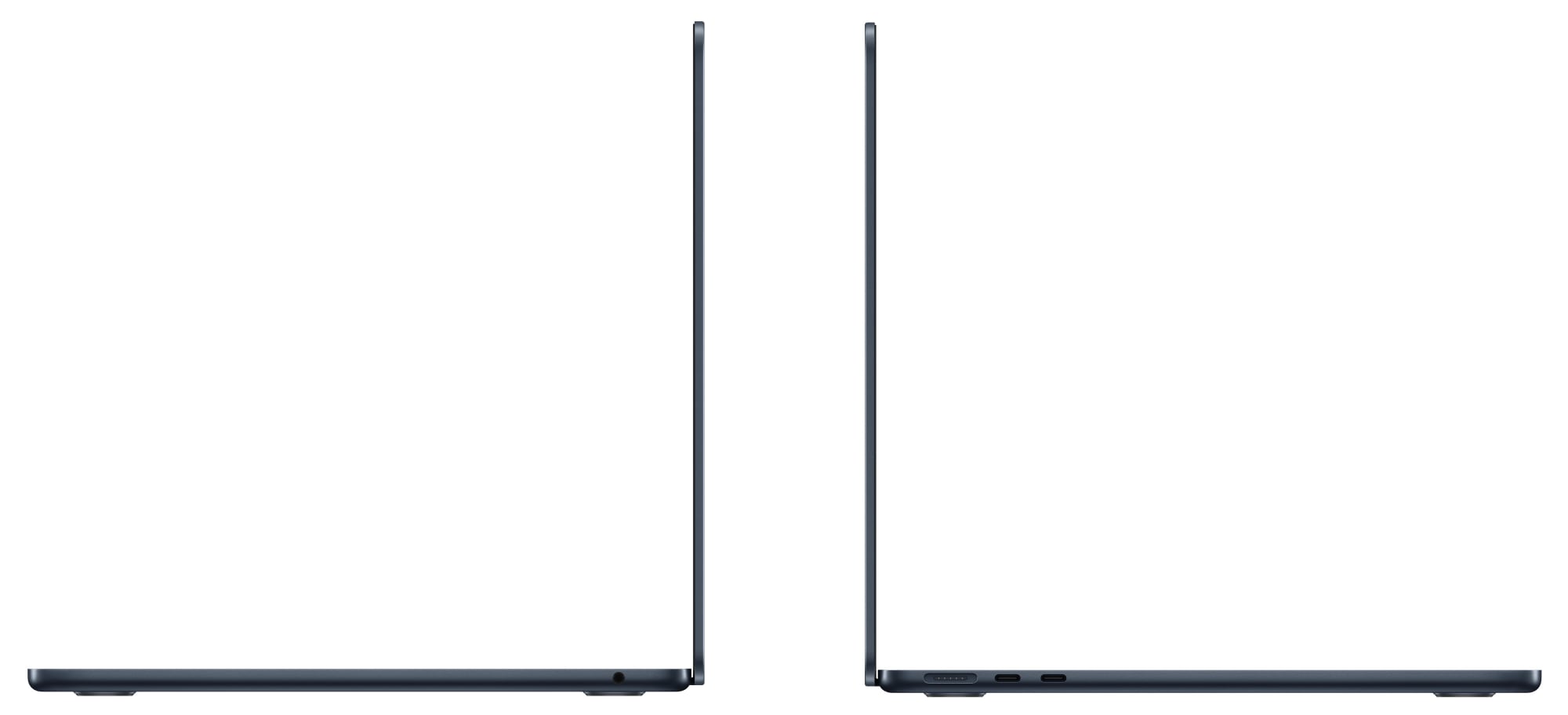
The uniform thickness of the M2 MacBook Air
Another design difference worth highlighting is that the M2 MacBook Air features a full-height function key row, rather than the M1 model's half-height row, and has a different Touch ID scanner design. The Magic Keyboards are otherwise the same. The full-height function row is unlikely to influence any purchasing decisions, but it is still worth highlighting amid bigger improvements.

Dimensions and Weight
The M2 MacBook Air is 0.19 inches (4.8 mm) thinner than the thickest point of the previous model. Both designs have the exact same width, but the M2 model is slightly longer. Despite not having a tapered design, the new MacBook Air delivers a 25 percent volume reduction over the previous generation and should feel more slight in the hand.


True to its name, the M2 MacBook Air is also 0.1 pounds (45 grams) lighter than the previous model.
M1 MacBook Air
- Height (at thickest point): 0.63 inches (1.61 cm)
- Height (at thinnest point): 0.16 inches (0.41 cm)
- Width: 11.97 inches (30.41 cm)
- Depth: 8.36 inches (21.24 cm)
- Weight: 2.8 pounds (1.29 kg)
M2 MacBook Air
- Height: 0.44 inch (1.13 cm)
- Width: 11.97 inches (30.41 cm)
- Depth: 8.46 inches (21.5 cm)
- Weight: 2.7 pounds (1.24 kg)
While the M2 MacBook Air does not deliver a massive change in terms of portability, its reduction in weight and volume are likely to be welcomed by users who often need to carry their device around. The M1 MacBook Air is by no means a large or overly heavy device, but the M2 MacBook Air is more likely to fit easily into tight bag compartments and be very slightly less cumbersome. The new design may be more striking and visually appealing, but it is generally not worth buying the latest model purely for better portability.
Color Options
Like many Apple devices, both models are available in Silver and Space Gray. The M2 MacBook Air is not available in Gold, but it offers Starlight and Midnight options.
If you have other Apple devices in Starlight and Midnight, such as an iPhone 13, iPad mini or iPad Air, or aluminum Apple Watch Series 7, you may prefer to get the M2 model to obtain a matching color. The unique champagne tone of Starlight or the navy-tinted hue of Midnight may also simply be more appealing, but Silver and Space Gray users have no reason to prefer the M2 model simply on the basis of color.
Display
Both models feature a high-resolution Retina display with P3 wide color and True Tone, but Apple boasts that the M2 MacBook Air features its latest "Liquid Retina display." This allows it to have slimmer borders, fitting a larger display in a similarly sized device, and the edges of the display curve around the top corners of the lid for a more modern appearance.
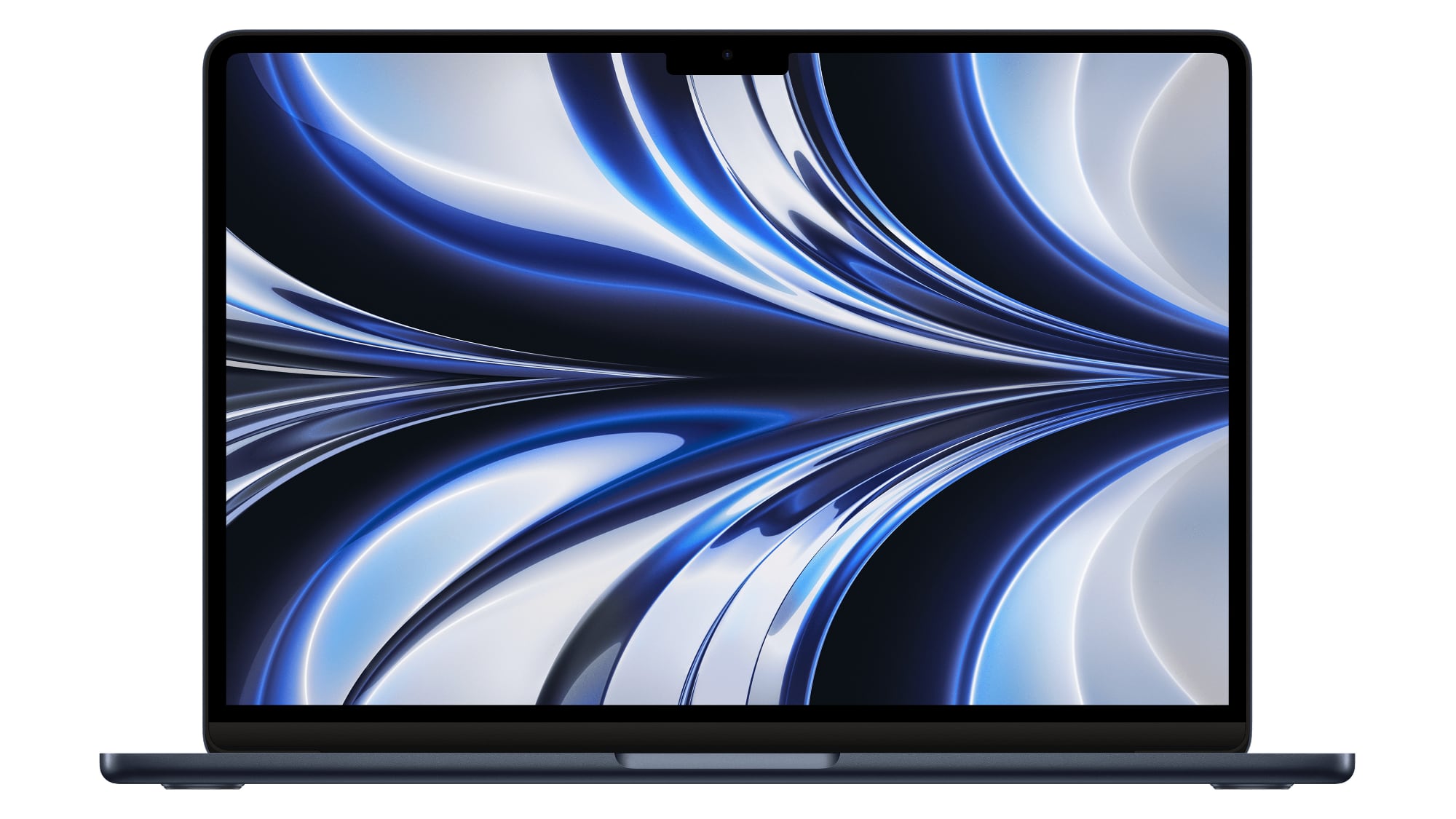
The M2 MacBook Air's display provides an additional 0.3 inches of diagonal space, making slightly more space for on-screen content, and the display can get 25 percent brighter than the M1 model, making it better for use outdoors, in direct sunlight, or in bright environments.
The M2 MacBook Air features a "notch" to house the FaceTime HD camera that cuts into the top of the display. While the displays feature different resolutions, they have the same 16:10 aspect ratio below the notch, so it should not be an important consideration for most buyers, especially since macOS's menu bar takes advantage of this additional vertical space on the M2 model.
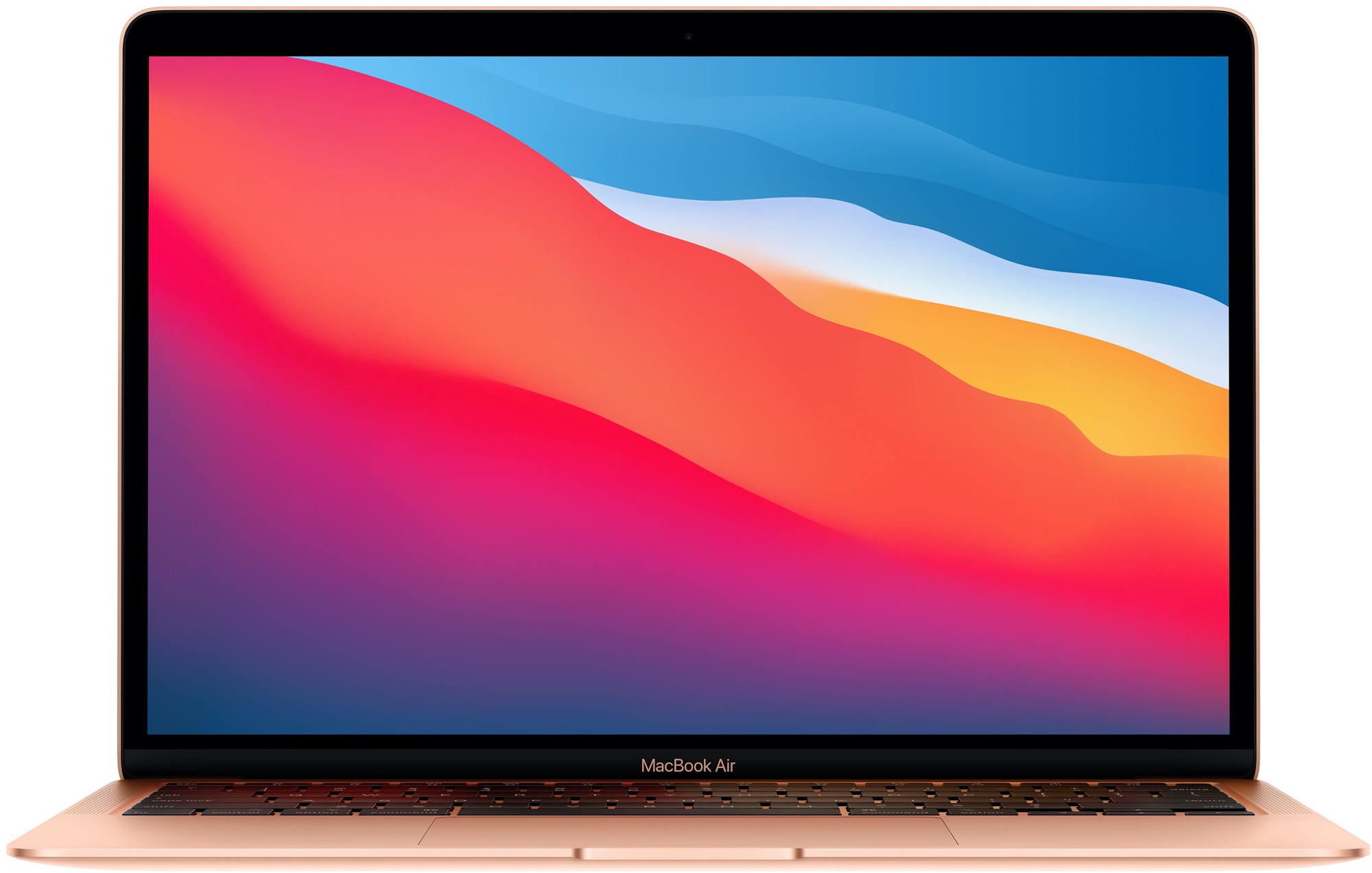
The M1 MacBook Air still has a more than serviceable LCD Retina display that will meet most customers' needs. There are few material differences between the displays in terms of specifications that make it worth buying one device over the other or upgrading, but the larger borders around the M1 model's smaller display certainly make it look more dated, which may sway some customers toward the newer model.
M1 vs. M2
One of the most important differences between the current and previous-generation MacBook Airs is their Apple silicon chip. The M1 chip, introduced in November 2020, is based on Apple's A14 Bionic chip. On the other hand, the M2 is based on the A15 Bionic chip from the iPhone 13.
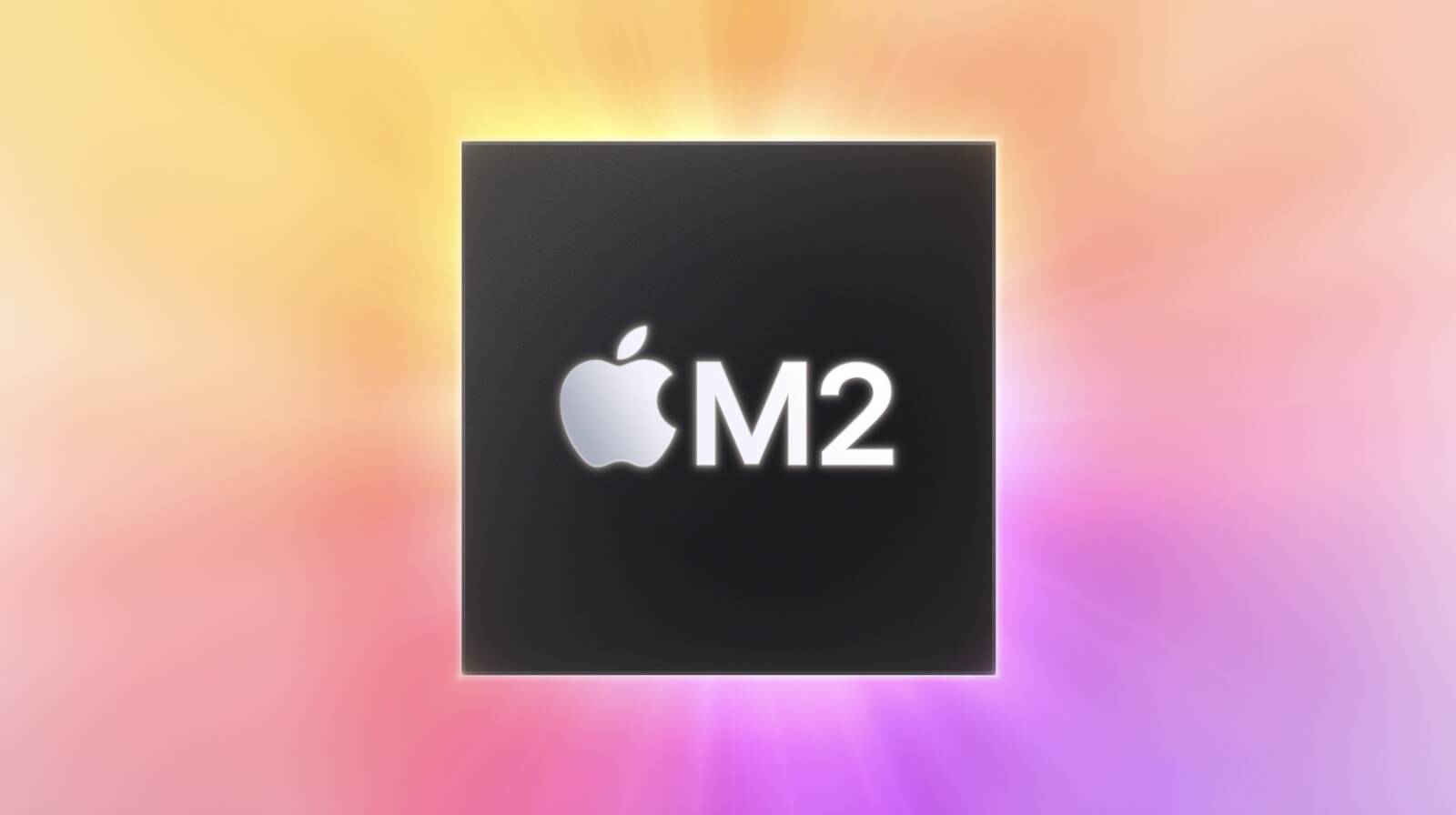
While both chips feature an eight-core CPU with four performance cores and four efficiency cores, the M2's cores offer moderate performance and efficiency improvements and up to two additional GPU cores. Apple says that with the M2 chip "intensive workloads like editing complex timelines in Final Cut Pro are nearly 40 percent faster than the previous generation... Applying filters and effects in apps like Adobe Photoshop is up to 20 percent faster than before."
Like the M1 Pro, the M2 features a media engine for hardware-accelerated ProRes and ProRes RAW video encode and decode. On the other hand, the M1 chip's dedicated media engine can only accelerate H.264 and HEVC video. Apple says that this dramatically speeds up video workflows on the latest MacBook Air, allowing users to play back up more 4K and 8K streams of video and convert video projects to ProRes considerably faster than before.
For casual users, the M2 chip is unlikely to make much difference over the M1 chip in day-to-day tasks, with improvements being more noticeable in professional workflows. For more information about the specific differences between the M1 and M2 chips, see our detailed guide:
Unified Memory
Both the M1 and M2 are configurable with 8GB or 16GB of unified memory, but the M2 offers an additional 24GB top-tier memory option. Multitasking and memory-hungry workflows, such as working with large assets, benefit from the higher memory option as a result.
In addition, the M2 has a 100GB/s memory bandwidth, compared to 68.25GB/s with the M1, meaning that the latest MacBook Air can access more memory faster.
Camera
The M2 MacBook Air includes a new 1080p FaceTime HD camera with twice the resolution and low-light performance of the previous generation, according to Apple. This is sure to substantially improve the video calling experience compared to the 720p camera of the M1 model.
Speakers
The M2 MacBook Air offers a four-speaker sound system integrated between the keyboard and the display, which Apple says "produce improved stereo separation and vocal clarity." The M1 MacBook Air retains a stereo speaker setup, which is likely to be good enough for most users. Both devices support wide stereo sound and Dolby Atmos playback.
Ports and Charging
The M2 MacBook Air ups the device's audio credentials further with support for high-impedance headphones like the high-end 14- and 16-inch MacBook Pros, which could be an important upgrade for some audio professionals.
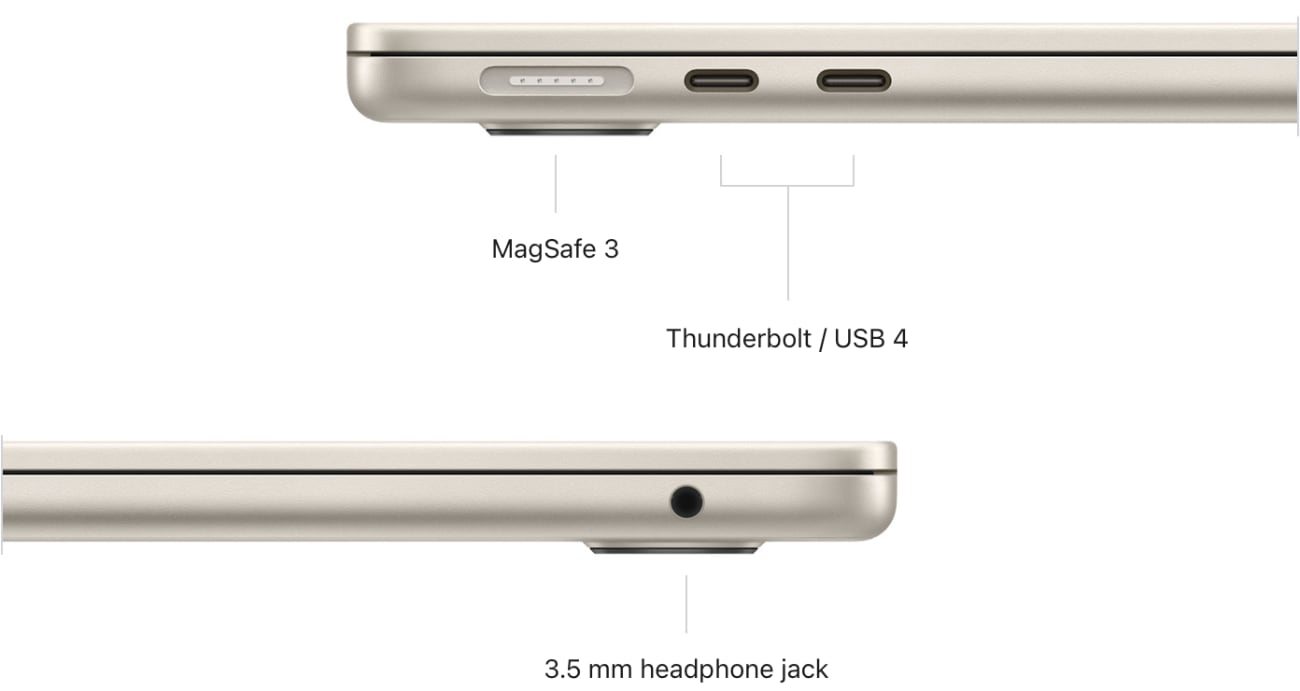
More noticeable is the presence of a MagSafe port on the M2 MacBook Air, allowing users to connect and release the charging cable from their MacBook Air more easily – especially if the charging cable is accidentally pulled, and see an LED indicator for the device's charging status.
Both models feature two Thunderbolt ports, so there is no outright difference when it comes to connecting accessories, but it is worth noting that the MagSafe port on the M2 model effectively frees up a Thunderbolt port for accessories that would otherwise need to be used for charging.
Though the M2 MacBook Air comes with a larger, 52.6-watt-hour lithium-polymer battery, both devices have the same 18-hour battery life. When using a 67W USB-C Power Adapter, the M2 MacBook Air supports fast charging.
M2 MacBook Air models configured with the 10-core GPU option come with a 35W Dual USB-C Port Compact Power Adapter, rather than the one-port 30W USB-C Power Adapter that comes with the M1 model and base M2 MacBook Air model.
Final Thoughts
In some senses, the M2 MacBook Air is similar to its predecessor, with the same Magic Keyboard and Force Touch trackpad, two Thunderbolt/USB 4 ports, a passive cooling system, and 18-hour battery life. The devices have a similar footprint, Retina display around 13 inches in size, up to 2TB of storage, can hardware-accelerate H.264 and HEVC video, and come with a 30W charger as standard.
That being said, there is no doubt that the M2 MacBook Air delivers a major redesign. Its uniform thickness, reduced volume and weight, larger display with slimmer borders, and full-height function row are sure to make for a more modern appearance. Yet there are also practical improvements such as the MagSafe port, fast charging, brighter display, 1080p FaceTime HD camera, and four-speaker sound system that meaningfully improve the user experience in many areas.
For these reasons, if choosing between buying the M1 MacBook Air or the M2 MacBook Air, it is worth spending the additional $200 for the M2 model's new design, better performance, and across-the-board improvements. That being said, if price is an issue, the M1 MacBook Air is still a very capable machine with plenty of similarities to the latest model.
Given that it has only been 18 months since Apple launched the M1 MacBook Air and the M1 chip continues to be offered in the iPad Air, iPad Pro, Mac mini, and iMac, the M2 MacBook Air will not be worth it for all users coming directly from the previous model. Some MacBook Air customers may wish to wait longer in between upgrades for even bigger changes.
When considering an upgrade from the M1 MacBook Air to the M2 model, users should weigh up how much they would utilize specific improvements. The M2 chip is unlikely to eclipse the M1 for everyday users, but for some workflows, it could offer real enhancements. For example, the M2's ProRes encode and decode engine, 100GB/s memory bandwidth, and 24GB memory option may make it a much more powerful device for professionals.
M1 MacBook Air users who need more than 16GB of memory, make lots of video calls, or even those who are prone to accidentally tugging on their charging cable should consider upgrading. The combined advancements of the new design, M2 chip, four-speaker system, larger display, and faster charging make switching the M1 MacBook Air for the M2 model a more worthwhile action than many other generation-over-generation upgrades.
The M2 MacBook Air may be best suited to those who are first-time MacBook Air buyers or are upgrading from an older machine, rather than 2020's M1 model. Nevertheless, the M2 MacBook Air is a significantly more appealing overall package with significant improvements in almost all areas, making it a justifiable upgrade for almost everyone.
Article Link: M1 vs. M2 MacBook Air Buyer's Guide: Is It Worth Upgrading?
Definitely no need to upgrade from M1 Air. Other than that when it comes to choosing between the two, M2 Air is better.
For your needs the choice is more aesthetic than technical. If you like the M1 wedge I wouldn't worry too much about MagSafe for most uses. The battery on the M1 lasts forever. I use mine at work doing software development and I still have 40-50% remaining at the end of an 8 hour day. If you can charge in a safe location at night you won't really care about MagSafe. The M1 is still wicked fast and is probably going to be in the lineup for another 12-18 months. Apple isn't likely to stop supporting it for at least 5 more years and probably longer.I've been asking the same question here and there, but I am still looking for an answer. The Long story short question is: M1 or M2 MacBook Air. I have a 2012 13" MacBook Air (4GB of RAM and 512GB of SSD). As a university teacher, I mainly work with Microsoft Office, videoconferencing, email, web browsing, watch movies and listen to music. My current MBA is starting to slow down and show some limitations, so I am thinking of getting a new computer in the near future. I don't know if should go for the M1 MBA or the M2 MBA. One of the thing I love about my 2012 MBA is MagSafe, but I don't know if it justifies the extra cash for the M2 MBA. I was thinking about upgrading the specs of my next MacBook to 16GB of RAM and 1TB of SSD. I ruled out the 14" MBP for two reasons: portability (I move my computer a lot and use it for presentations in all my classes) and because I think I won't be using the extra-power the MBP offers. Another thing that worries me is that the M2 MBA is losing the wedge- shape and it might have an effect in the comfort, when typing for hours. On the other hand, what makes me hesitate about going for the M1 MBA (which is still a great value) is the fact that is a 2-year-old model, with and even older chassis design. What should I do? Any recommendations?
The only technical reason you might want the M2 is for the improved camera since you do a lot of videoconferencing.
You might also look at refurbished models on Apple's site or buy used from somewhere else. My babied M1 MacBook Air is going up for sale on swappa.com in August.
"This is sure to substantially improve the video calling experience compared to the 720p camera of the M1 model" if it's anything like the "improved" camera on the Macbook Pro, that's unlikely. Far too much software jigger pokery going on. Someone I was talking to thought I'd had cosmetic surgery, or had loads of makeup on!
I agree with point 1 but I just can't make myself care about fast charging or MagSafe since the battery on the M1 MacBook Air runs for well over a normal workday. I charge at night and just don't think about it during the day.The 2 biggest factors:
1. 24GB RAM ceiling makes this way more viable. 16GB is just too limiting.
2. Faster charging / faster RAM make it more attractive.
I would have preferred a M2 MBA v M2 MBP comparison.
That's better than putting in in the bin, but still not ideal.When you trade it in to Apple, they refurbish and resell it to someone else.
When you give it to a family member or friend or sell it to someone, they are using it. Does the planet care if you or someone else is using it?
I fail to see the issue here.
The difference between what you and me think is that by doing things your way will not decrease the amount of devices produced every year.
And this is exactly what needs to be done.
Electronic devices are obviously just one part of the picture, but the do make a difference indeed.
Oh come on. 2016 MacBook Pro butterfly experiment, squared off iPhone 4, Jony Ive’s first software fantasy venture, what could go wrong?Never buy version 1 of anything.
Would it be a better value to get a Refurbished M1 Air 16Gb 256 at $921 direct from Apple with a 10% military discount versus a base M2 8G/256 for $1079? Looking to keep the machine at least 3-4 years.
After doing a ton of research on the RAM question, it seems like it doesn't matter a ton for people who aren't doing web development, video editing, statistical programming, etc. I think an 8G would last 3-4 years for normal productivity work, even with some occasional more intensive work.Would it be a better value to get a Refurbished M1 Air 16Gb 256 at $921 direct from Apple with a 10% military discount versus a base M2 8G/256 for $1079? Looking to keep the machine at least 3-4 years.
That said, I went with the 16G cause I will mainly using the machine for statistical analysis, and I want to keep it for 5+ years.
1. 24GB RAM ceiling makes this way more viable. 16GB is just too limiting.
What do you run that uses 24GB? Something like VMware virtualization can but isn't really viable on AS.
Would it be a better value to get a Refurbished M1 Air 16Gb 256 at $921 direct from Apple with a 10% military discount versus a base M2 8G/256 for $1079? Looking to keep the machine at least 3-4 years.
Why buy refurb? I see new M1 MBA 16GB 256GB for $950 no tax on San Francisco FB marketplace. Offer $900. M2 isn't worth $500+tax more and you want to avoid 8GB.
I agree with point 1 but I just can't make myself care about fast charging or MagSafe since the battery on the M1 MacBook Air runs for well over a normal workday. I charge at night and just don't think about it during the day.
The OS uses more RAM than you think and I unless I open Pixelmator or Photos or iMovie, I am just running Safari, Mail, Devonthink, and a few other apps. But with some apps / extensions in the background, and some Safari tabs open, it crawls up to 11-13GB easily without Pixelmator. So yes, having a bit more room is important.What do you run that uses 24GB? Something like VMware virtualization can but isn't really viable on AS.
DockerWhat do you run that uses 24GB? Something like VMware virtualization can but isn't really viable on AS.
I ran out of storage space long ago and constantly shift files around to make more. Also, I do a lot of video compression, and it’s really slow.Well, if your retina MBP satisfies your needs now, then why upgrade? As long as your data is backed up, then the worst that can happen is that you have to buy a new computer when the current one fails. And if the MBP makes it another year then you will have newer, more powerful options.
I’ve been saving for 10 years 😂It all boils down to how much you want to spend.
I will definitely consider that, I was under the impression that the Apple Refurbs are just as good as buying new. Do you think 16gb of RAM is even worth the extra cash versus buying a base M1 or M2? I use cloud storage mostly and the 256 should be more than enough.Why buy refurb? I see new M1 MBA 16GB 256GB for $950 no tax on San Francisco FB marketplace. Offer $900. M2 isn't worth $500+tax more and you want to avoid 8GB.
I will definitely consider that, I was under the impression that the Apple Refurbs are just as good as buying new. Do you think 16gb of RAM is even worth the extra cash versus buying a base M1 or M2? I use cloud storage mostly and the 256 should be more than enough.
8GB is already insufficient and if you plan to keep it longer term for 3-4 years then 16GB is the #1 criteria above anything else. Factory new is best since zero wear on battery and SSD. With refurb you don't know if it's been water damaged before and repaired but not 100%.
Just make sure it's not device or user locked. Or, ask for copy of receipt.
https://support.apple.com/guide/deployment/activation-lock-depf4ab94ef1/web
Register on MacRumors! This sidebar will go away, and you'll see fewer ads.


